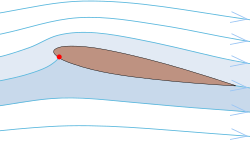Stagnation point


As a stagnation point (engl. Stagnation point ) is the point on the surface of an incident flow body ( profile indicated) on which the flowing fluid impinges perpendicularly theoretically. The speed of the flow disappears at the stagnation point, so that the kinetic energy (in the idealized case completely) is converted into pressure energy. The pressure in the stagnation point is therefore the greatest compared to other places on the body surface and is referred to as the total pressure . The streamline that ends as the only one at the stagnation point is usually referred to as the stagnation point streamline .
On wings , the stagnation point is on the leading edge of the profile . When the angle of attack changes, the position of the stagnation point also changes: as the angle of attack increases, the stagnation point moves a little to the underside of the wing (see illustration). As a result, the incoming air, which hits the leading edge immediately above the stagnation point, has to travel a short distance in the opposite direction to the incoming air in order to reach the top of the profile.